|
American
Auto Industry-Built Anti-Aircraft Guns in World War Two
This page added 7-1-2020.
Military historians have generally overlooked the American
Automobile Industry's contribution to the production of anti-aircraft
guns during World War Two.
While there is some recognition of the 40mm Bofors that Chrysler and the
20mm Oerlikon that Hudson built, the volumes and various types
of anti-aircraft guns built by General Motors and Willys-Overland have
gone unnoticed. When consolidated in the table below, it
can be seen that the American Auto Industry built both anti-aircraft
guns and components of all sizes from the .50 caliber machine gun to the 120mm
anti-aircraft gun, the largest built in the United States during the
war.
Definition: A complete
anti-aircraft gun was the operating gun mechanism and the barrel.
Mounts may or may not have been have been built by the manufacturer of
the operating weapon. In the case of the 40mm Bofors, both
Chrysler and Pontiac built the weapons, but other companies built the
mounts.
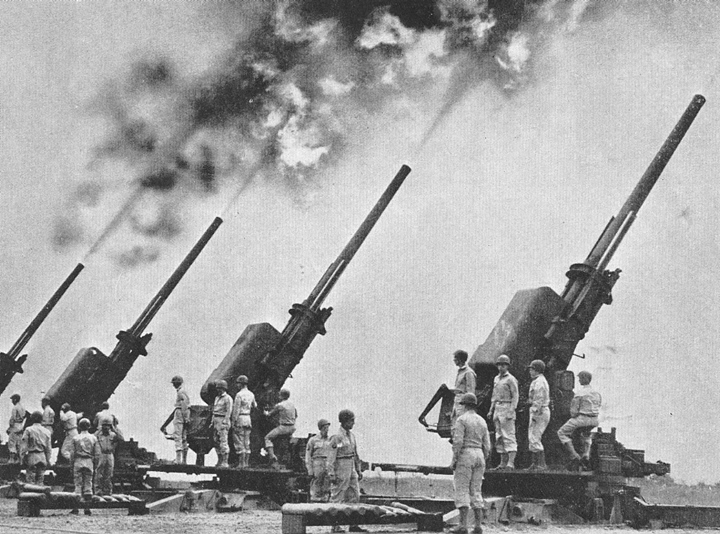
Ka-Boom times four! All of the 120mm
anti-aircraft guns, like the four firing simultaneously here, were built
by the General Motors Fisher Body Divisions Grand Rapids plant.
|
Summary Table - American Auto
Industry Built Anti-Aircraft Guns
This table includes not only completed weapons but
components to the weapons that were produced by the American
Automobile Industry. Dark shading indicates assembly of a
complete weapon. |
|
Weapon |
Company |
Gun Mechanisms |
Gun Tubes |
Breeches |
Gun
Mounts |
Complete Anti-Aircraft Guns |
Comments |
| .50
Caliber HB Browning |
AC
Spark Plug Division of GM |
100,000 |
100,000 |
Included in Mechanism |
|
100,000 |
This
is an estimate based on total General Motors build of
1.27million machine guns produced in four different GM Divisions. |
| 1.1 inch
|
Willys-Overland |
|
|
3,374
Breech Housings and Recoil Cylinders for 1.1 inch anti-aircraft
guns |
|
|
|
| 20mm Oerlikon |
Hudson |
33,201 |
33,201 |
Included in Mechanism |
33,201 |
33,201 |
Production started 7-7-41 and ended 10-43. |
| 20mm
Oerlikon |
Pontiac |
Unknown Amount |
47,026 estimated. See
calculations below. |
Included in Mechanism |
39,275 estimated single mounts. 5,760
twin 20mm Oerlikon mounts. |
Yes |
Pontiac started production before
Pearl Harbor. |
| 40mm
Bofors US Navy |
Chrysler |
28,884 |
28,884 |
Included in Mechanism |
|
Yes |
Chrysler reported 14,442 Dual 40mm Bofors at the end of the war. |
| 40mm
Bofors US Army |
Chrysler |
30,095 |
51,684 |
Included in Mechanism |
|
Yes |
Gun
Mechanisms is an end of war number. Gun tubes is as of
3-31-44. |
| 40mm
Bofors US Army |
Pontiac |
4,900 |
17,892 |
Included in Mechanism |
|
Yes |
|
| 40mm
Bofors US Army |
Firestone |
|
|
|
20,231 |
Yes |
Firestone mounted the weapons provided by Chrysler, Pontiac and
other gun manufacturers onto mounts. In essence, it was
the final assembler of a complete weapon. |
| 40mm
Bofors US Navy |
Firestone |
|
|
|
10,434 |
Yes |
Same
as above. |
| 3-inch/50-caliber
Dual Purpose Naval Gun |
Fisher Body Division of GM- Detroit Die and Machine |
|
|
9,459 |
|
|
|
| 90mm
US Army |
Fisher Body Division of GM- Pontiac Plant |
|
|
|
|
2,359 |
|
| 90mm
US Army |
Buick
Division of GM |
|
|
|
2,402 |
|
Buick (2,952) 90mm and 4.7 Anti-Aircraft Gun
Mounts, |
| 90mm
US Army |
Chevrolet
Division of GM |
|
2,000 |
2,000 |
|
|
Breech Block, Breech Ring, Recoil
Rails, and bored and rifled the 15-foot gun tube |
| 120mm
US Army |
Fisher Body Division of GM-Grand Rapids Stamping Plant
|
|
|
|
|
550 |
|
| 120mm
US Army |
Buick
Division of GM |
|
|
|
550 |
|
|
| 5-inch/38-calliber
inch Dual Purpose Naval |
Fisher Body Division of GM- Detroit, MI Die and Machine |
|
|
6,342
total Breech Housings between Detroit and Grand Rapids Plants.
Detroit Die and Machine built the majority of the housings. |
|
|
March
1944: 300 per month both plants combined
|
| 5-inch/38-calliber
inch Dual Purpose Naval |
Fisher Body Division of GM- Grand Rapids, MI Stamping Plant |
|
|
6,342
total Breech Housings between Detroit and Grand Rapids Plants |
|
|
March
1944 300 per month both plants combined
130 per month |
| 5-inch/38-calliber
inch Dual Purpose Naval |
Fisher Body Division of GM-Pontiac, MI |
|
|
|
480 |
|
|
.50 Caliber Browning Machine Guns:
AC Spark Plug Division of General Motors built an estimated 100,000
M2 HB .50 caliber Browning machine guns. The .50 caliber machine
gun was used on just about every type vehicle, small ship, boat, and
aircraft during the war. One of its main functions was providing
low altitude anti-aircraft protection for army units and its vehicles.
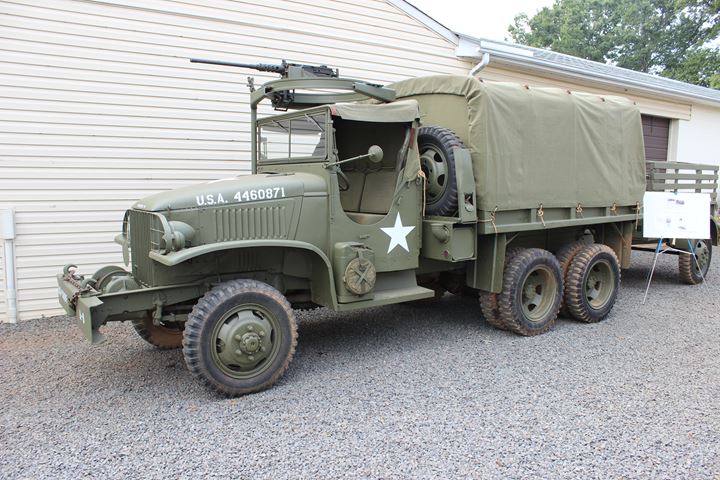
Quartermaster vehicles needed protection
against low-flying aircraft. This GMC CCKW-352 was on display at the
Virginia Museum of Military Vehicles 2016 Open House. Author's
photo.
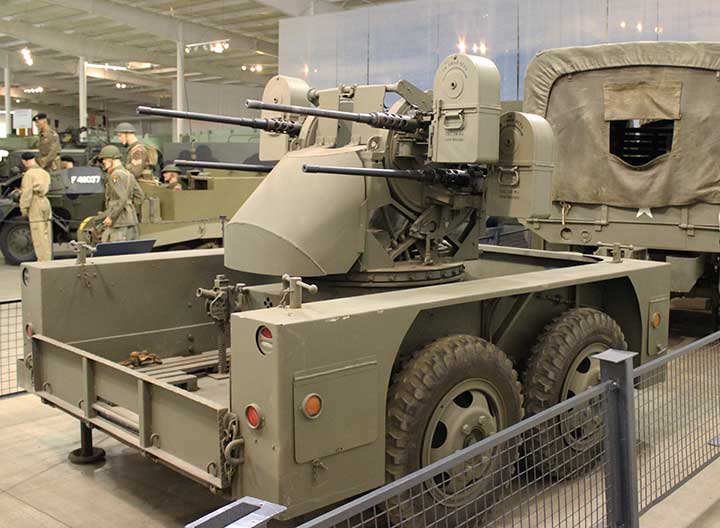
Four .50 caliber machine guns were used in
the M45 quad mount anti-aircraft gun mount trailer. Author's
photo.
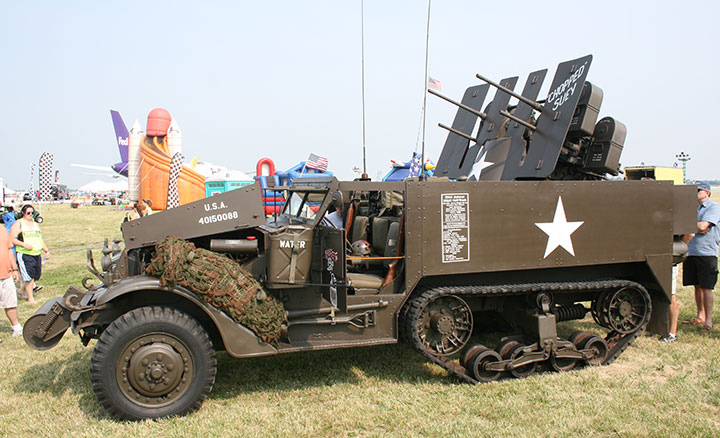
The .50 were also mounted on M3 half-tracks
which were re-designated as M16s. Author's photo.
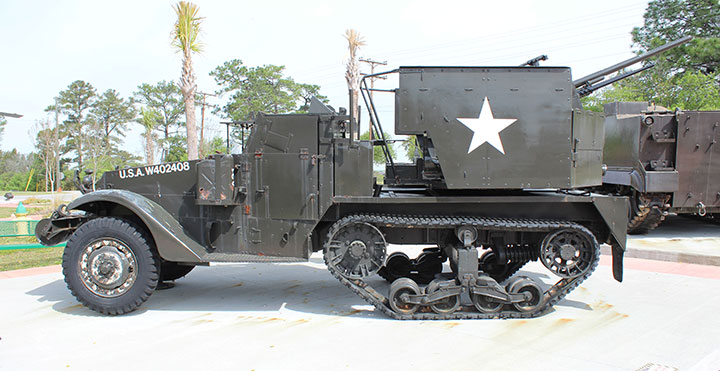
The M15 half-track mounted two .50 caliber
machine guns and one 37mm cannon for providing anti-aircraft defense.
This on is on display at Fort Jackson, SC. Author's photo.
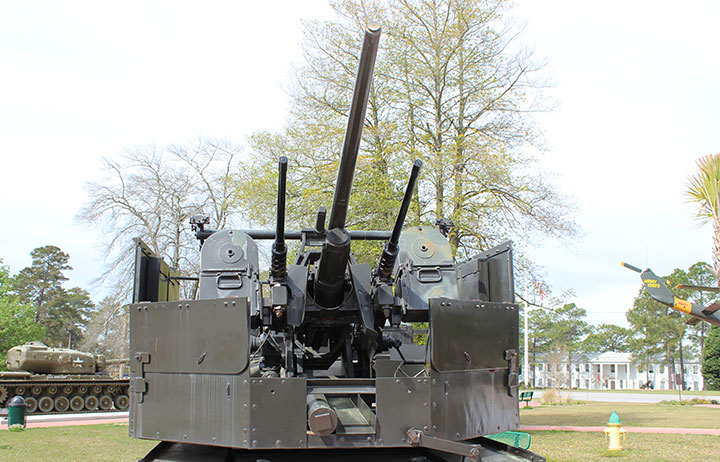
Author's photo.
1.1 inch Anti-Aircraft
Guns for the US Navy: Willys-Overland is most well known for
building Jeeps during World War Two. A look at my Willys-Overland
page reveals that it had a large and diversified product line during the
war. Included in this product line were 3,374 breech housings and
recoil cylinders for the weapon. The 1.1 inch quad mount was the
low level anti-aircraft gun on U.S. Navy ships at the beginning of World
War Two. However, the weapon was problematic; and for the most
part was replaced by the 20mm Oerlikon and the 40mm Bofors. At the end of the war, there were still some 1.1 inch weapons
still on navy ships. The 1.1 was too heavy and not able to move
fast enough as a close in-weapon. On the other hand it was too
small a caliber to serve as an intermediate weapon between a heavy
machine gun and a five-inch dual purpose gun. In 1940, even though
the 1.1 was scheduled for replacement by both the 20mm Oerlikon
and 40mm Bofors, production was increased while manufacturers
tooled up for its replacements. A 1.1-inch was better than no
weapon at all. Willys-Overland was part of this pre-war buildup.
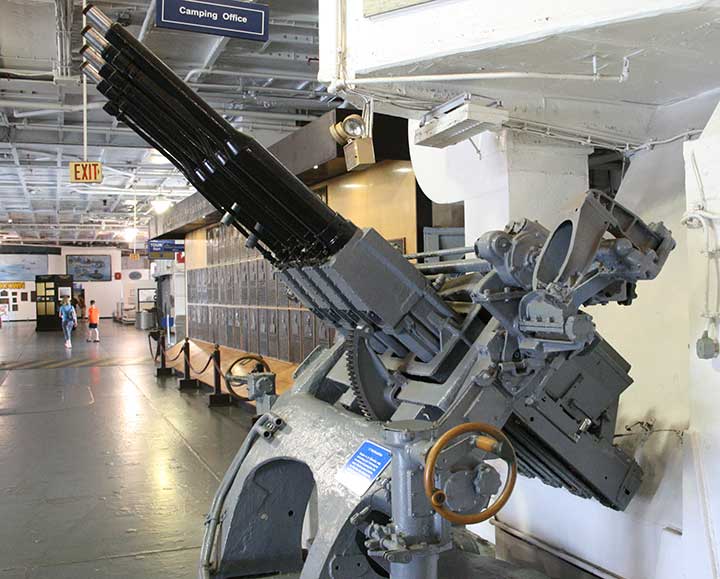
The 1.1-inch (28mm) quad mount anti-aircraft
gun was used by the US Navy during the first part of World War Two.
Prone to overheating and jamming if not properly maintained, the weapons
were replaced on US Navy ships, for the most part, by the both the 20mm Oerlikon and 40mm Bofors cannon
later in the war. Willys built 3,374 breach housings
and recoil cylinders for the weapons starting in 1941 and ending in
1943. As seen on the USS Yorktown at Patriots Point, SC.
Author's Photo.
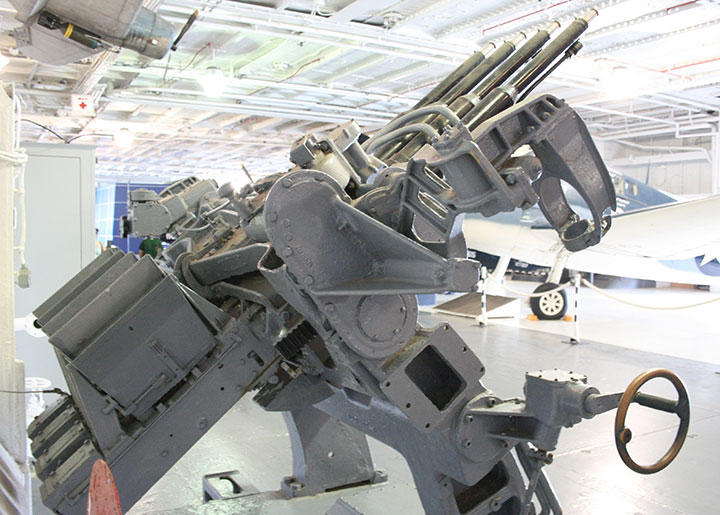
Author's Photo.
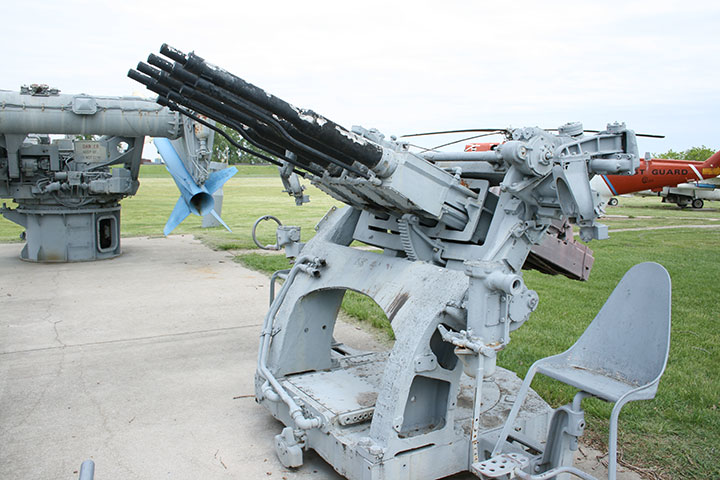
Here is another 1.1-inch quad mount
photographed in Freedom Park, Omaha, NB. This one has one of the
gunner's seats still attached. This weapon may not exist anymore.
Freedom Park is/was right along the Missouri River in Omaha and has been
devastated several times since my visit by flooding. The park is
supposed be moved to safer area. Author's Photo.
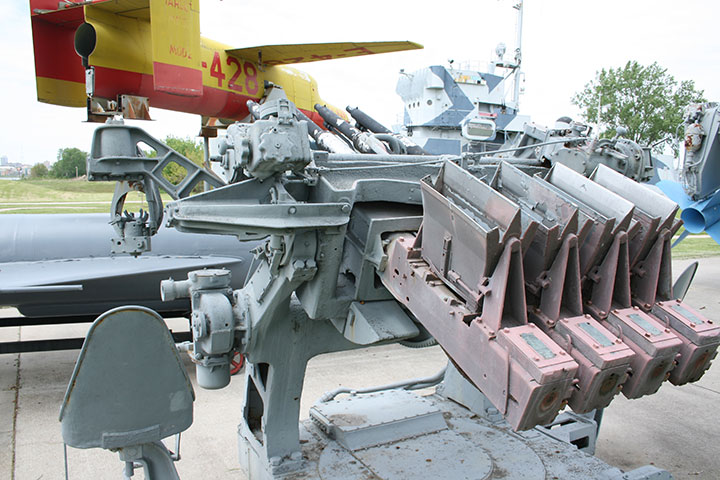
This photo gives a good view of the feed trays
for the 1.1-inch shells. Author's Photo.
20mm Oerlikon Anti-Aircraft Guns for
the US Navy: There were
four companies that produced 146,956 20mm Oerlikon cannon during World
War Two. Two of them were from the auto industry, Pontiac and
Hudson. The U.S. Navy replaced Hudson with Westinghouse as the
managing company at the U.S. Navy Ordnance plant in Centerline, MI in
October 1943. The fourth company was American Oerlikon Gazda
Corporation.
In December 1941, contracts with each company
gave a monthly production rate. While there are no known
production numbers available for the individual companies of the 20mm
cannon, with the exception of Hudson, a total production is available.
With this information, an estimate of each manufacturer can be made and is done in
Table 1 below.
Pontiac 20mm Oerlikon anti-aircraft cannon
photos: There are two different dates found for the beginning of
the 20mm program at Pontiac. "Pontiac at War," shown below, gives
March 6, 1941. The "U.S. Navy Bureau of Ordnance in WWII" by
Buford Rowland gives a contract signing date of April 3, 1941. In
any event, eight months before Pearl Harbor, Pontiac started work on the
production of the 20mm Oerlikon cannon for the United States Navy. The
original contract was for 2,000 weapons for the British through
Lend-Lease. The contract was then modified for another 4,000
weapons. It is unknown whether the 4,000 units were for the
British or the U.S. Navy. The initial production rate was for
200-400 weapons per month. At the time of Pearl Harbor Pontiac had
delivered 115 weapons.
The weapon included both the gun and the mount
as shown in the first set of photos below.
Between June 1941 and December 1945 a total of
146,956 20mm Oerlikon guns were produced. It is known that Hudson
built 33,201 guns. From the table below, it can be seen that
Pontiac produced an estimated 47,026 20mm Oerlikon cannons.
|
Table 1 -
Production of 20mm Oerlikon Cannon in World War Two |
|
Company |
Contracted Monthly Production Rate - 20mm Oerlikon Cannon |
%
of the Total Production Contracted |
Estimated or Known Number of 20mm Oerlikons built |
Comments |
|
American Oerlikon Gazda Corporation |
500 |
27 |
39,678 - Estimated |
|
|
Pontiac |
600 |
32 |
47,026 - Estimated |
Pontiac delivered 115 weapons previous to Pearl Harbor. |
|
Centerline Naval Ordnance Plant -Hudson |
750 |
41 |
Confirmed
33,201 out of estimated 60,252 |
Hudson did not deliver any weapons until after Pearl Harbor.
Production started 7-7-41 and ended 10-43. |
|
Centerline Naval Ordnance Plant -Westinghouse |
750 |
41 |
27,051 - Estimated |
Westinghouse took over production at Center Line in 10-43. |
|
Totals |
1,850 |
100 |
146,956 |
|
The same thought process can be used to
estimate the number of single weapon mounts that Pontiac and others
built during the war. There were a 122,735 mounts built by the
same four companies at the same three locations.
|
Table 2 -
Production of 20mm Oerlikon Mounts in World War Two |
|
Company |
Contracted Monthly Production Rate - 20mm Oerlikon Mounts |
%
of the Total Production Contracted |
Estimated or Known Number of 20mm Mounts built |
Comments |
|
American Oerlikon Gazda Corporation |
500 |
27 |
33,139 - Estimated |
|
|
Pontiac |
600 |
32 |
39,275 - Estimated |
Pontiac delivered 115 weapons previous to Pearl Harbor.
Pontiac also built 5,760 twin 20mm Oerlikon mounts under a
separate contract starting January 1945. |
|
Centerline Naval Ordnance Plant -Hudson |
750 |
41 |
Confirmed
33,201 out of estimated 50321 |
Hudson did not deliver any weapons until after Pearl Harbor.
Production started 7-7-41 and ended 10-43. |
|
Centerline Naval Ordnance Plant -Westinghouse |
750 |
41 |
27,051 - Estimated |
Westinghouse took over production at Center Line in 10-43. |
|
Total |
|
100 |
122,735 |
|
Hudson: To date, I have been unable to find any of the 33,201 20mm Oerlikon
guns or mounts that Hudson made. Those that I have found were built
by Westinghouse after the U.S. Navy replaced Hudson as the manager of
the Centerline, MI Naval Arsenal with Westinghouse in October 1943.
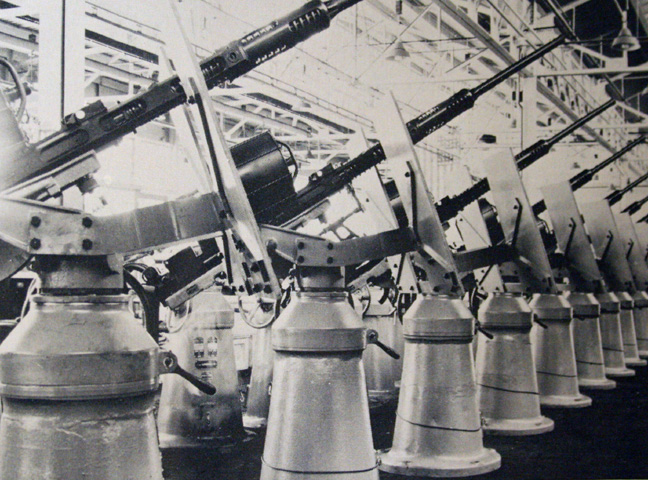
This Hudson factory photo shows a few of the
33,201 20mm Oerlikon guns and mounts it built over a two year
period during World War Two. Note that Hudson built a solid circular
mount for the weapons. Pontiac produced a different type as shown
below.
Pontiac Motor Division of General Motors:
Pontiac built an estimated 47,026 20mm Oerlikons for the US Navy.
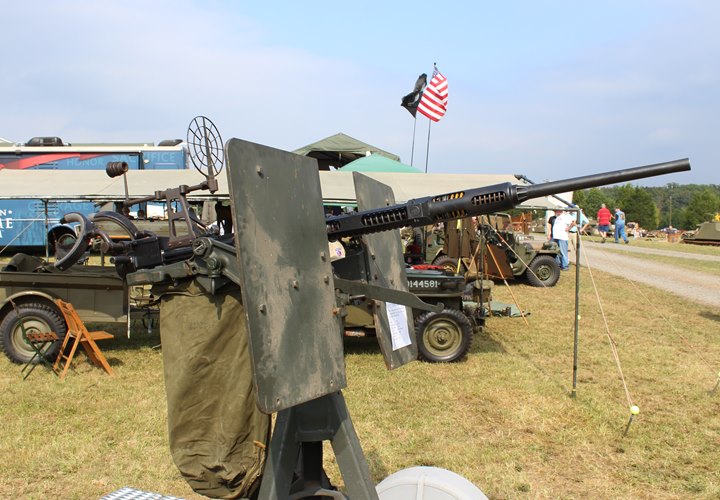
Pontiac's first war job was building
20mm Oerlikon anti-aircraft cannons for the US Navy. This
particular weapon, along with the stand and gun sight, were all built by
Pontiac. This weapon is serial number 223843. Author's photo
from the 2016 Virginian Museum of Military Vehicles Open House.
This is the best and most complete Pontiac
unit I have found. All the components were built by the Pontiac
Motor Division of General Motors. For some unknown reason the data
plates give General Motors Corporation of Pontiac as the builder.
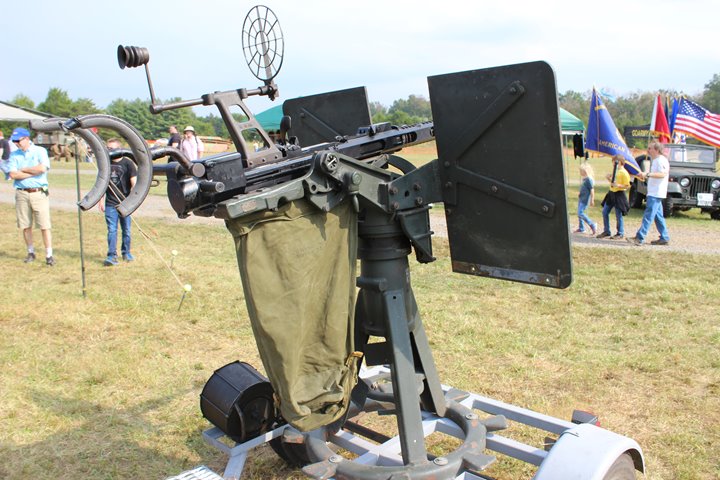
Author's photo.
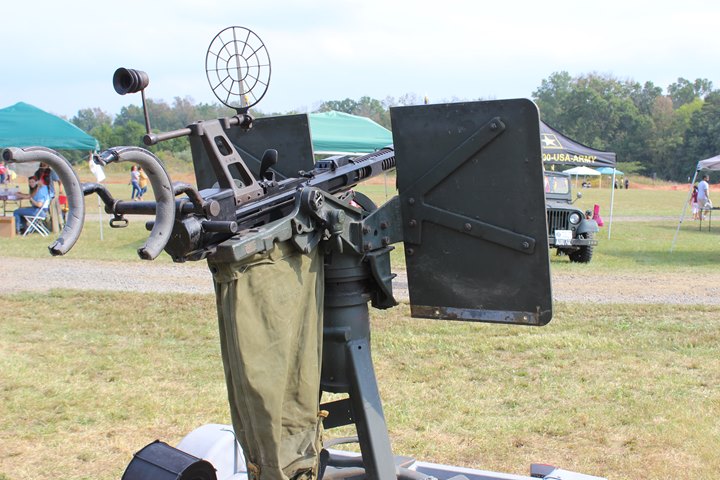
Author's photo.
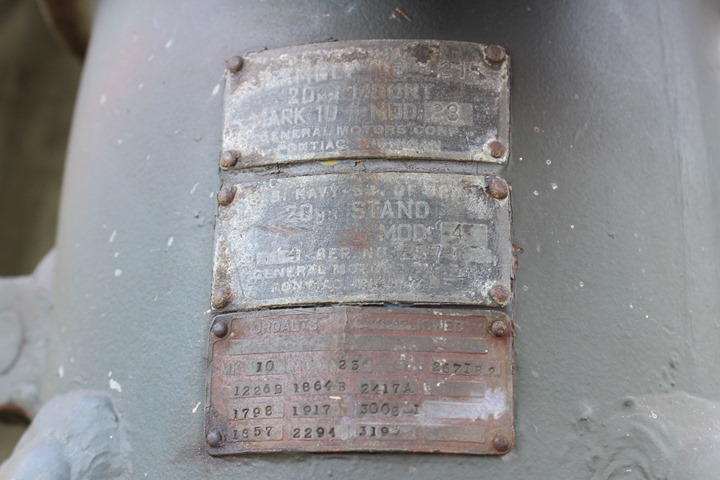
Data plates on the Mark 10 20mm gun stand.
The serial number on the middle plate is 267182. This matches the serial
number on the bottom plate. Author's photo.
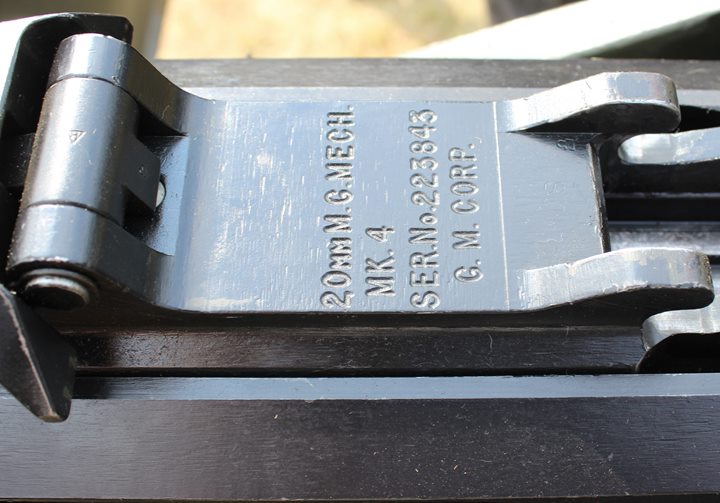
The serial number on the Mark 4 gun breach
is 223843. Author's photo.
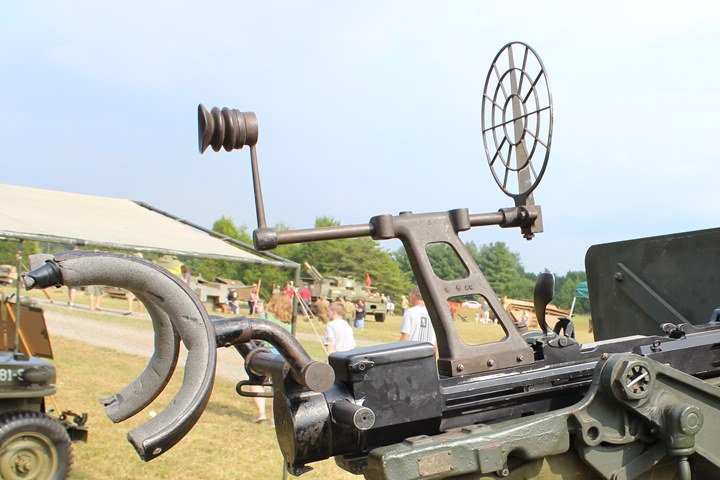
The brass Mark 4 gun sight assembly was also
manufactured by Pontiac. Author's photo.
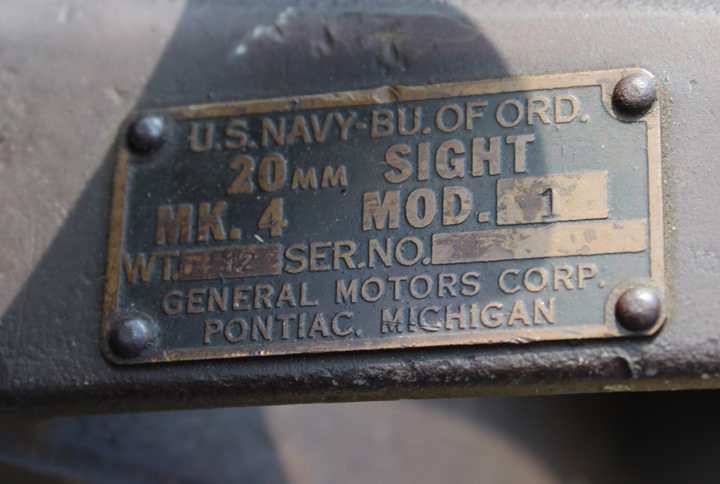
It has a weight of 12 pounds. Author's
photo.
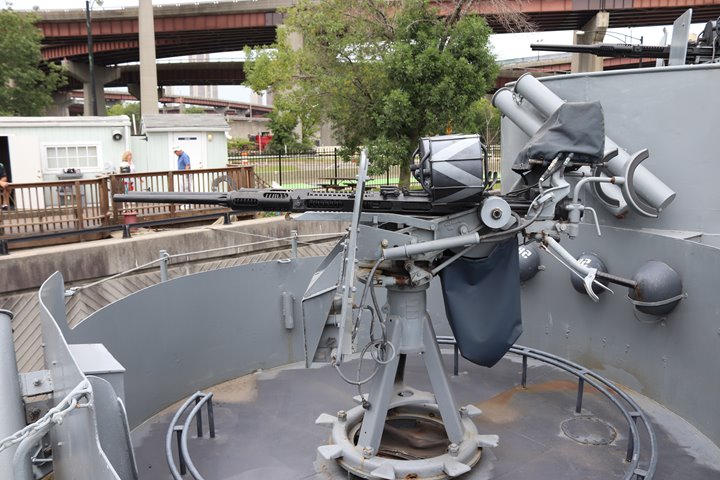
This twin 20mm Oerlikon anti-aircraft gun is on the destroyer escort USS
Slater in Albany, NY. The weapon closest to the camera was
built by Pontiac. Author's photo.
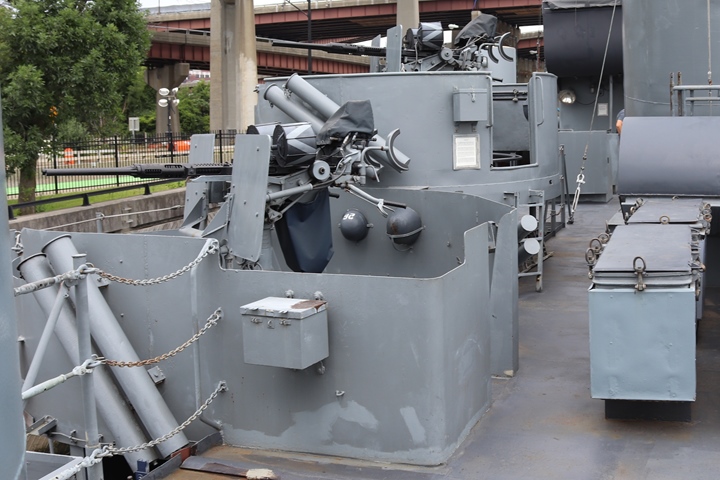
Both of the 20mm mounts in both gun tubs are
twin mounts. These could be part of the 5,460 Pontiac built.
Author's photo.
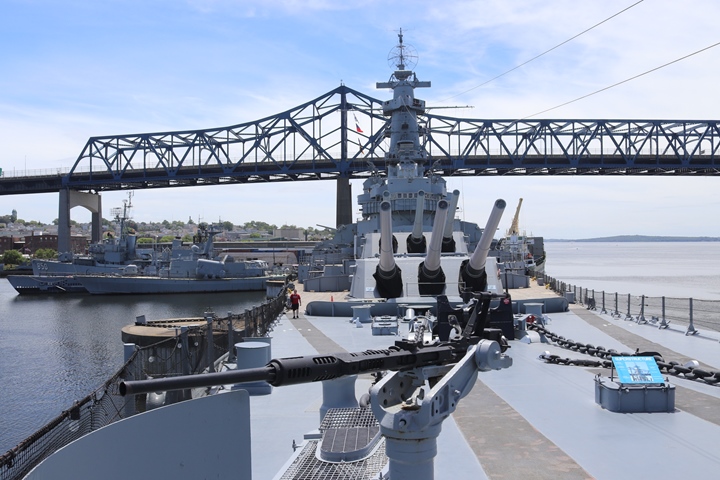
This is the USS Massachusetts at Fall River,
MA. The Oerlikon 20mm cannon in the foreground was built by
Pontiac. Author's photo.
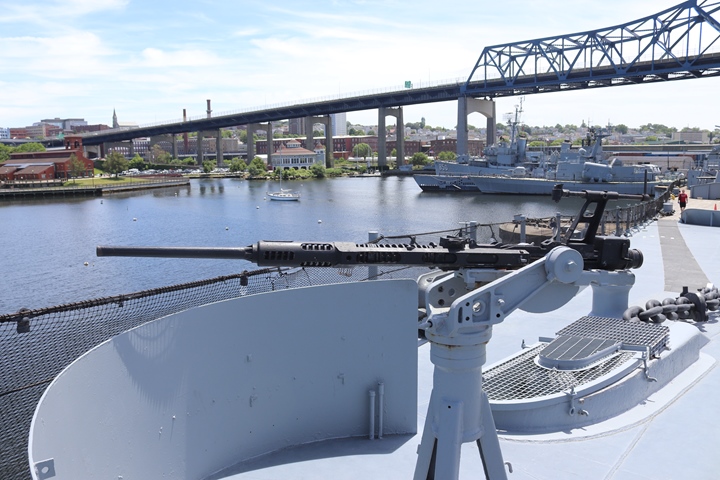
Author's photo.
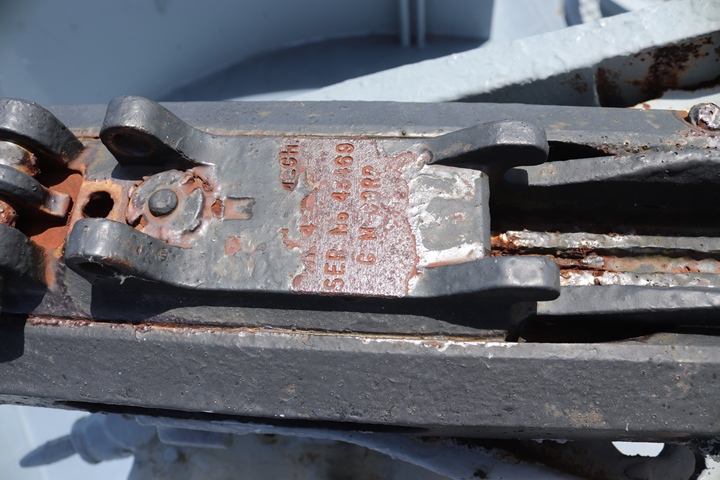
This is Serial Number 43469. Author's
photo.
40mm Bofors Anti-Aircraft Cannon:
Chrysler:
Chrysler built 14,442 Dual 40mm Bofors for the U.S. Navy during
World War Two. Some of these weapons can be found on museum ships.
In many cases the data plates on the weapons are missing, painted over,
or just illegible due to weathering. However, in some cases, the
data plates tell which weapons were built by Chrysler.
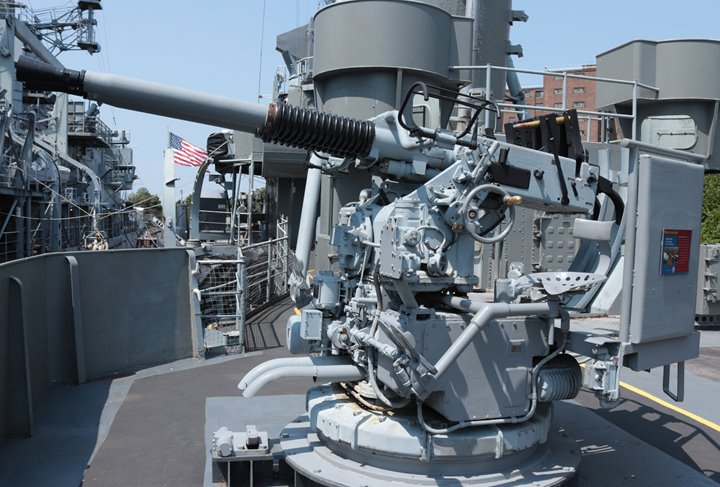
During World War Two,
Chrysler built 40mm water cooled Bofors Guns for the US Navy
under license from the Bofors Company of Sweden. After
Chrysler engineers set up the manufacturing and assembly techniques
based on the mass manufacturing, the weapon could be assembled in ten
hours. Bofors in Sweden was taking 450 hours.
This example is located on the USS Sullivans in Buffalo, NY, and is
located on the middle of the ship on the starboard side. It should
be noted that Chrysler built only the firing portion of the total weapon.
The gun mounts were built by other companies.
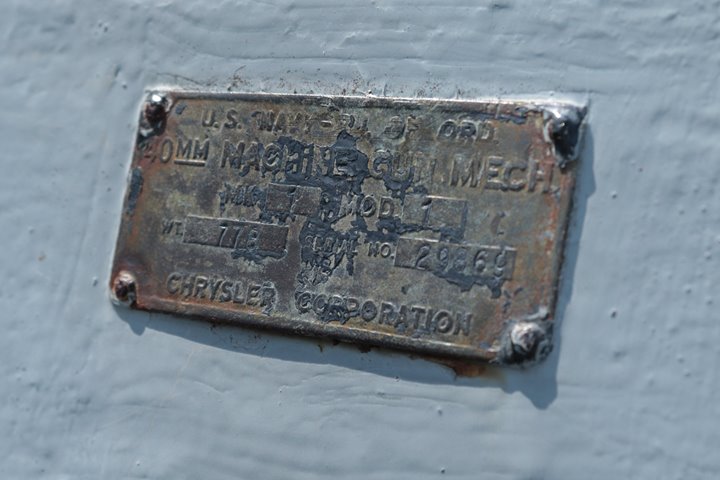
There is a data plate on each barrel
and assembly. This one is mounted on the breech of the gun facing
the rear of the ship. This Chrysler-built 40mm Bofors gun
mechanism is
serial number 29869. Author's photo.
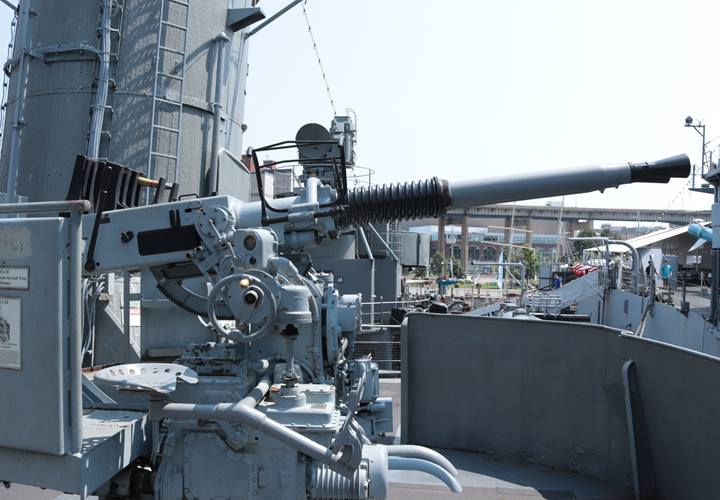
This is the other gun of the pair. Author's photo added
10-12-2017.
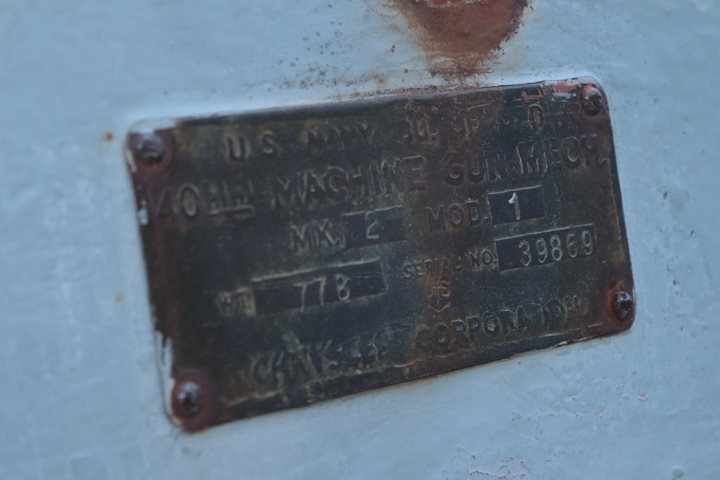
Here is the data plate for the gun mechanism for the gun facing the front of the ship.
This one is serial number 39869. What are the chances of a gun
mount having two Chrysler 40mm guns with serial numbers separated by
exactly10,000 units? Author's photo.
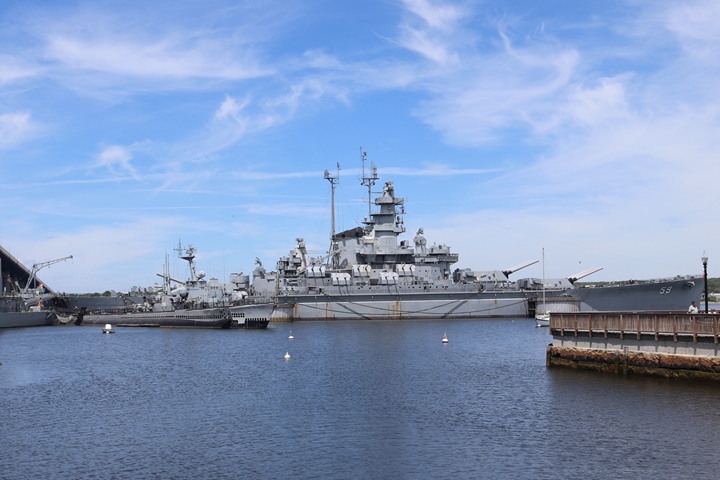
This is the USS Massachusetts at Fall River,
MA. A visit to the USS Massachusetts in June 2019 revealed that
most, if not all, of the 40mm Bofors anti-aircraft guns onboard were
built by Chrysler in 1942. This makes sense because the
Massachusetts was launched in September 1941 and commissioned on May 12,
1942. The Chrysler-built Bofors outfitted the battleship in 1942
as the weapons were coming off the assembly lines. All of the 40mm
Bofors I was able to visit on the USS Massachusetts were built by
Chrysler. Author's photo added 12-16-2019.
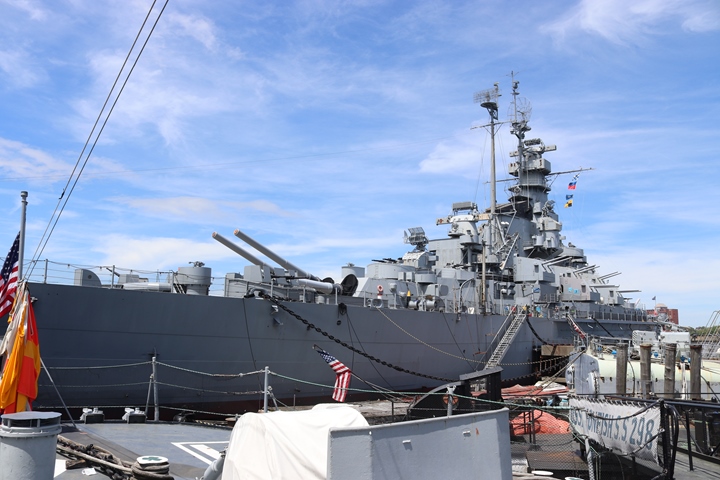
The USS Massachusetts bristles with 16-inch,
5-inch and 40mm guns. Author's photo added 12-16-2019.
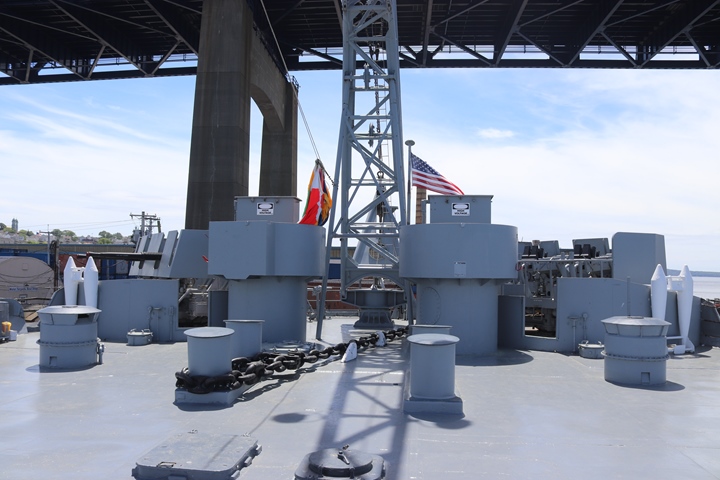
There are two gun tubs on the fantail
of the USS Massachusetts with two dual 40mm Bofors mounts in each.
Author's photo.
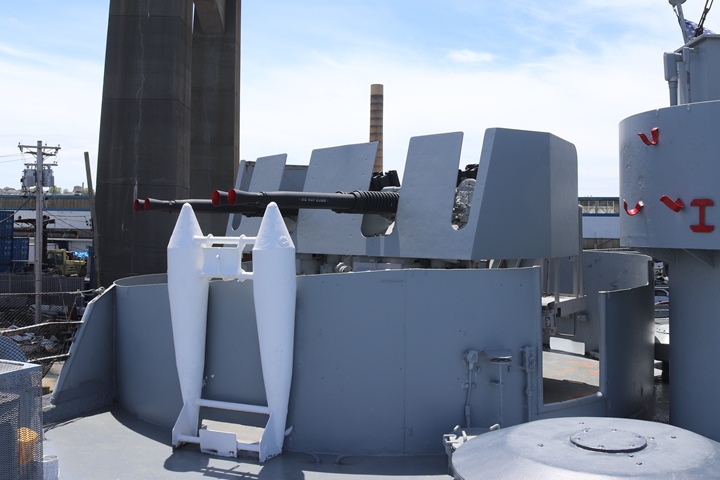
The serial numbers from the four
Chrysler-built 40mm Bofors in the starboard side rear quad 40mm gun tub
are shown below. Author's photo added 12-16-2019.
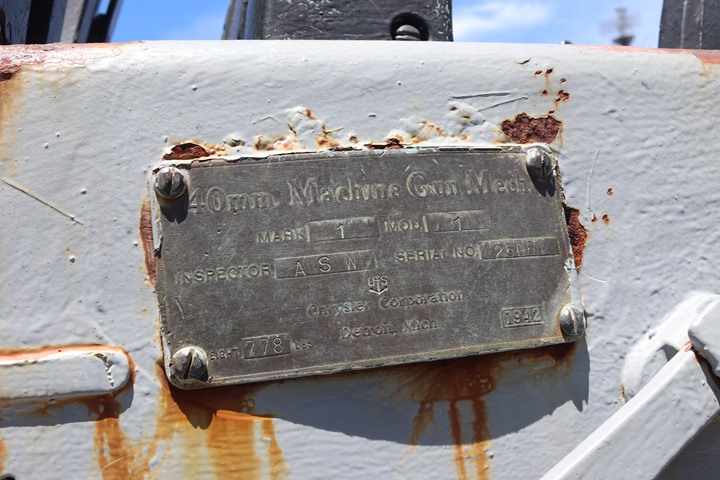
This is serial number 25067. Author's
photo.
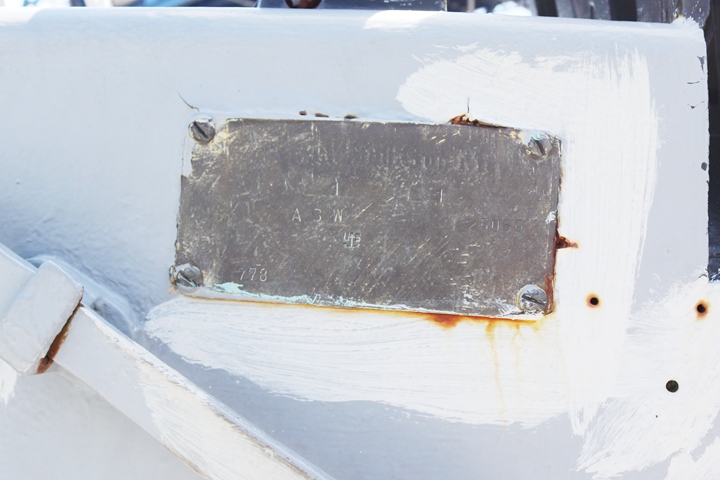
I have lightened this data plate as it was on the shade side of the
weapon. It is so worn that it is hard to read. This is
serial number 25065, just two less than the previous matching gun in the
twin mount. Author's photo.
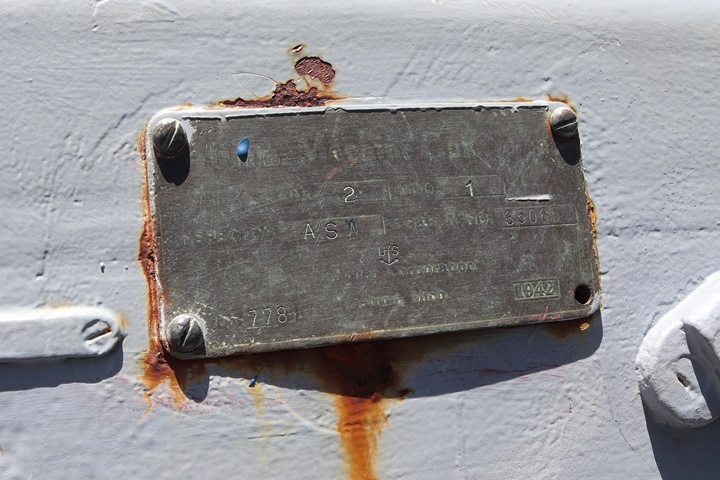
This is serial number 35065. Author's
photo.
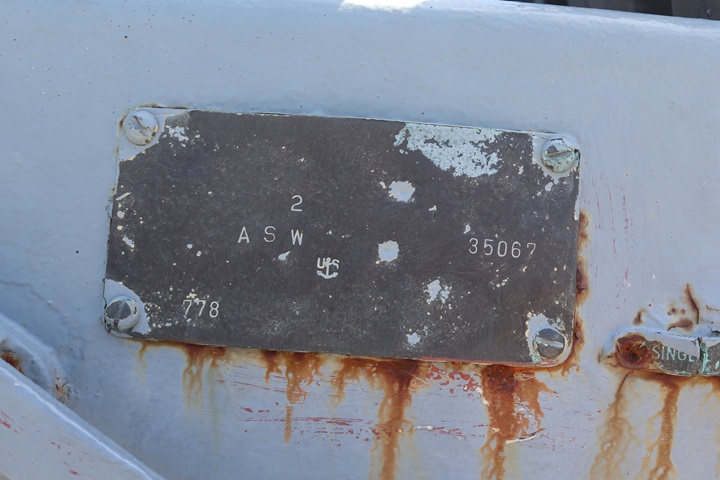
This is serial number 35067, two more than the matching gun in the twin
mount. Author's photo.
Chrysler produced 30,095 gun mechanisms and
51,684 gun tubes for the U.S. Army M1, M1A1, M2 and M2A1 anti-aircraft
guns, and for U.S. Navy M3 single-gun ship-mounted guns.
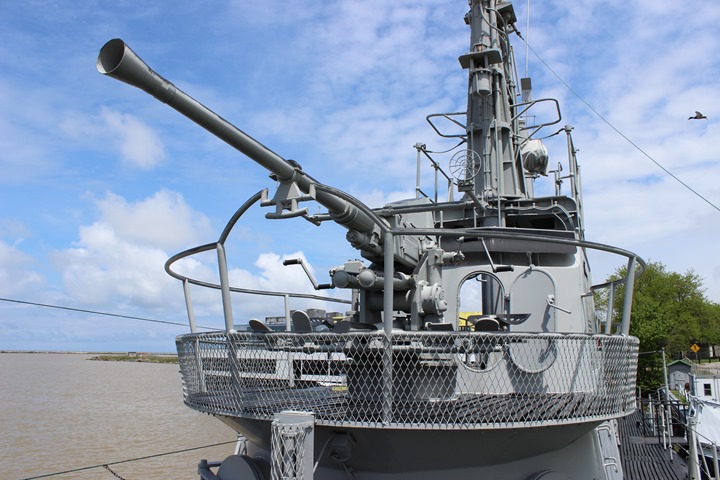
The Navy used the single mount with Chrysler
40mm gun mechanisms and tubes. Author's photo.
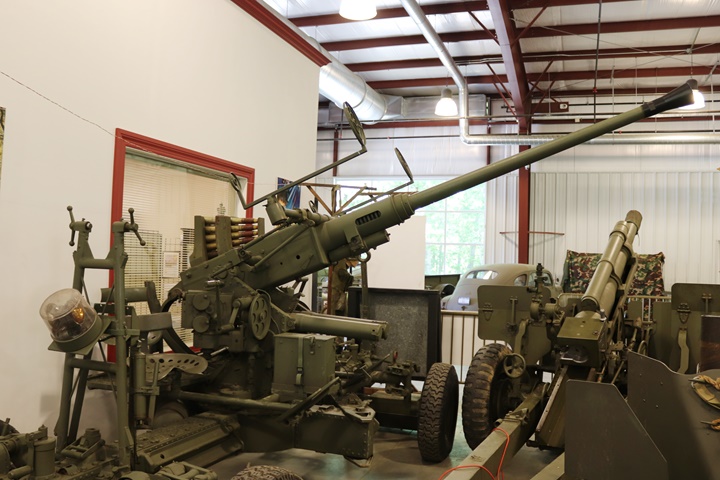
Chrysler-built 40mm mechanisms and gun tubes
went it into Army anti-aircraft guns like this one on display at the
Museum of American Armor on Long Island, NY. Author's photo.
Pontiac Motor Division of General Motors:
Pontiac produced 4,900 gun mechanisms and 17,892 gun tubes through
March 1944.
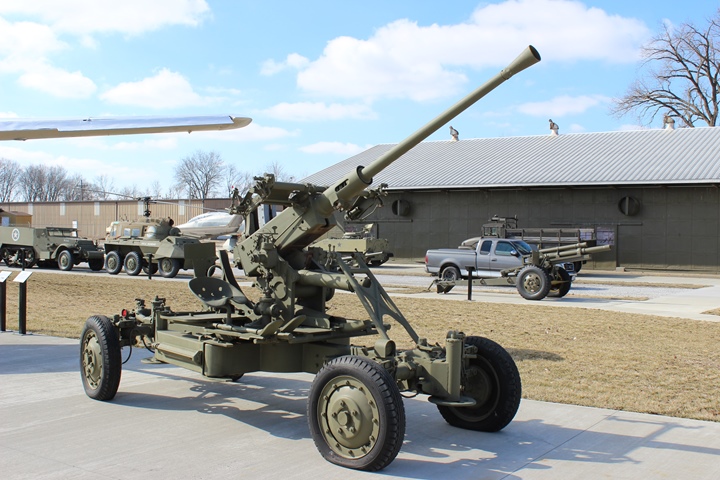
Pontiac began work on the 40mm Bofors anti-aircraft gun mechanisms and
gun tubes in January 1942.
Pontiac cleared 217,000 square feet of the sheet metal plant space to
manufacture the weapon. The Bofors could fire 130 rounds per
minute, and the two pound projectiles had a range of 5,420 yards.
Author's photo.
The information for the two tables below
comes from "The History of the Americanization of the Bofors 40mm
Automatic Antiaircraft Gun" written by the Historical Section of the
Ordnance Department in May 1944.
Pontiac produced 16.5% of the gun mechanisms
and 20.8% of the gun tubes for the US Army 40mm Bofors like the one
shown above. Note that the information came from an article
written in May 1944. Over a year of war still remained,
and the need for gun tubes continued.
|
Production
of 40mm Gun Mechanisms for the US Army as of March 1944 |
|
Company |
Date |
Quantity |
Percentage |
Comments |
|
Chrysler |
3-31-1944 |
24,802 |
83.5% |
|
|
Pontiac |
After
12-1943 |
4,900 |
16.5% |
This was the scheduled amount that was completed some time
in 1944. |
|
Total |
|
29,702 |
|
|
|
Production
of 40mm Gun Tubes for the US Army as of March 1944 |
|
Company |
Date |
Quantity |
Percentage |
|
Chrysler |
3-31-1944 |
51,684 |
60.2% |
|
Pontiac |
3-31-1944 |
17,892 |
20.8% |
|
Otis Fensom |
3-31-1944 |
16,258 |
18.9% |
|
War Supplies |
10-42 |
40 |
0.1% |
|
Total |
|
85,874 |
|
Firestone Tire and Rubber Company:
Firestone built 20,231 40mm gun carriages for the U.S. Army
during World War Two. It received the assembled gun mechanisms and
tubes from both Chrysler and Pontiac, and then assembled them into the
gun carriages. It also built 10,434 single-gun mounts for the U.S.
for use on submarines, PT boats, and other small water craft.
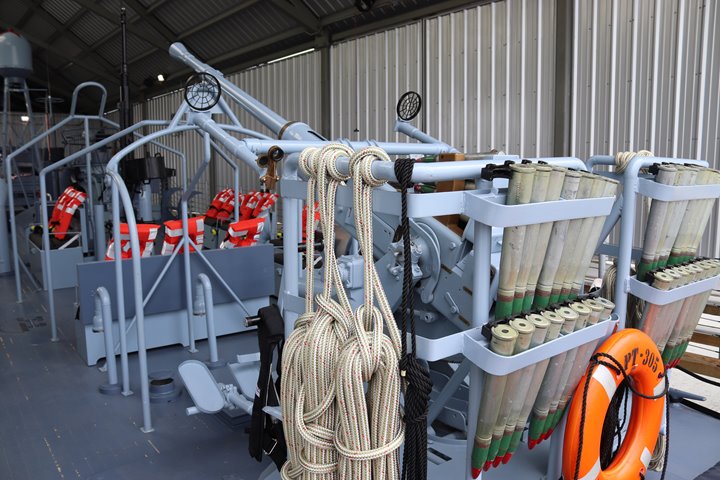
This 40mm anti-aircraft gun with a Firestone
Navy gun mount is on PT-305 in New Orleans, LA. Author's photo.
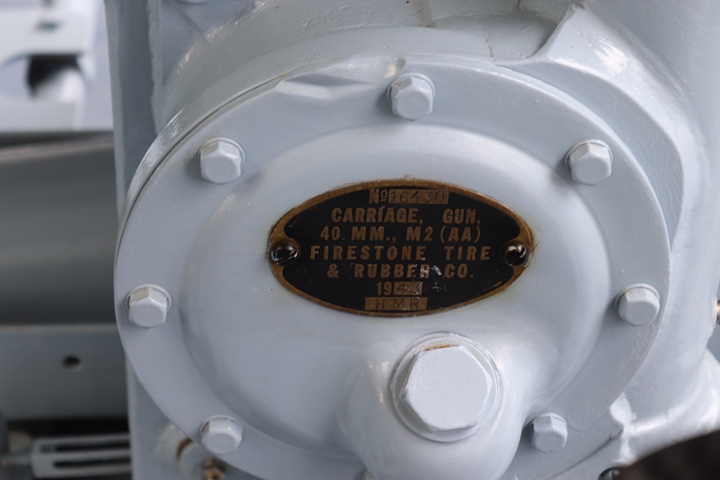
This carriage is serial number 16430 which
was built in 1943. Author's photo.
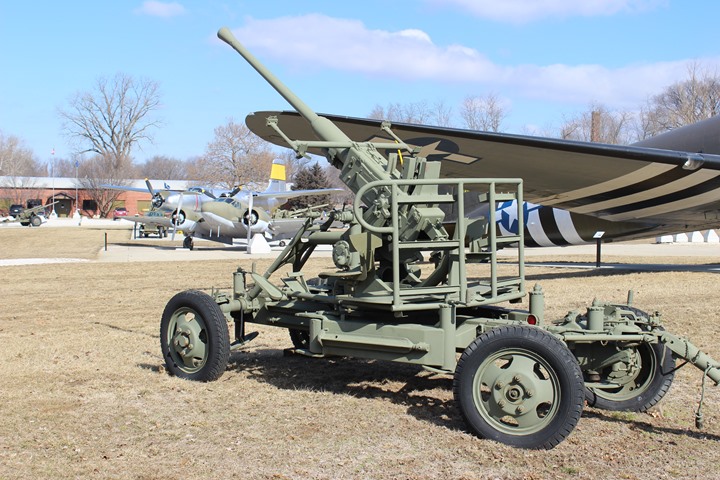
A Firestone-built 40mm Bofors mount and
carriage can be
seen at the Indiana Military Museum in Vincennes, IN. Author's
photo.
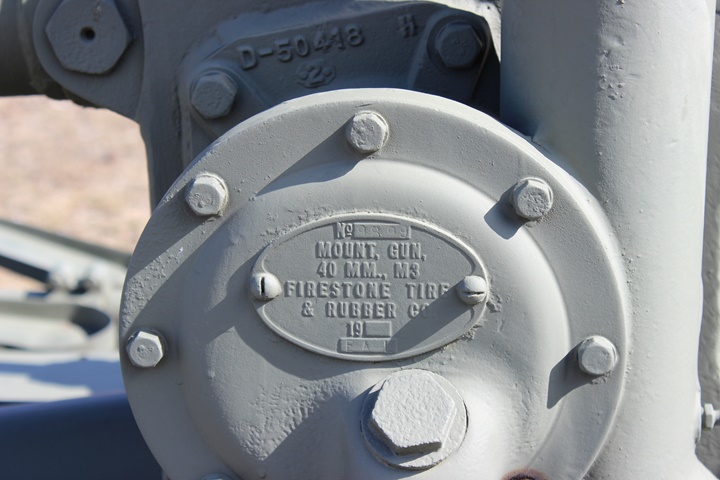
This is an M3 mount and is serial number
9899. Author's photo.
3-inch/50-caliber Naval Dual-Purpose Guns:
The Fisher Body Division of General Motors Die and Machine plant in
Detroit, MI built 9,459 breeches for the 3-inch gun during World War
Two.
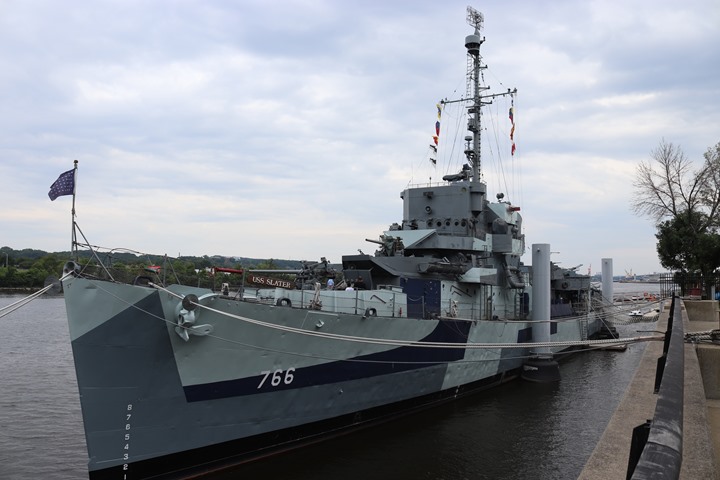
The number one three-inch/50-caliber gun on
the USS Slater DE-766 has a Fisher Body-built breech. The USS
Slater is on display along the Hudson River water front in Albany.
It is the only Cannon Class Destroyer Escort on display in the world.
Author's photo.
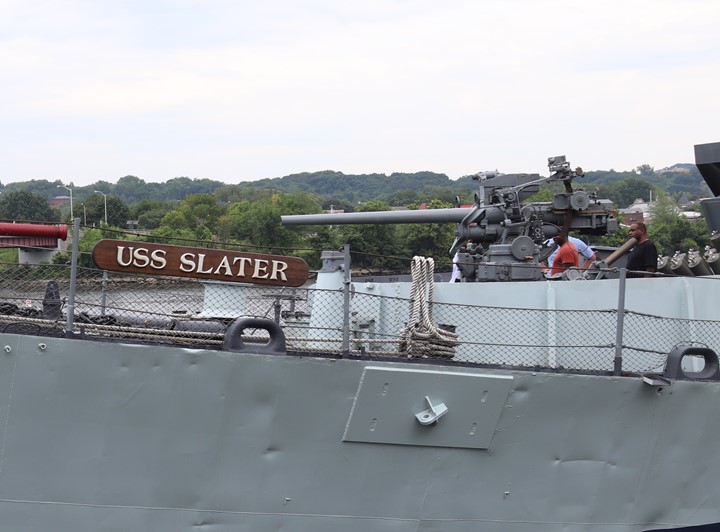
The number one gun on the USS Slater.
Author's photo.
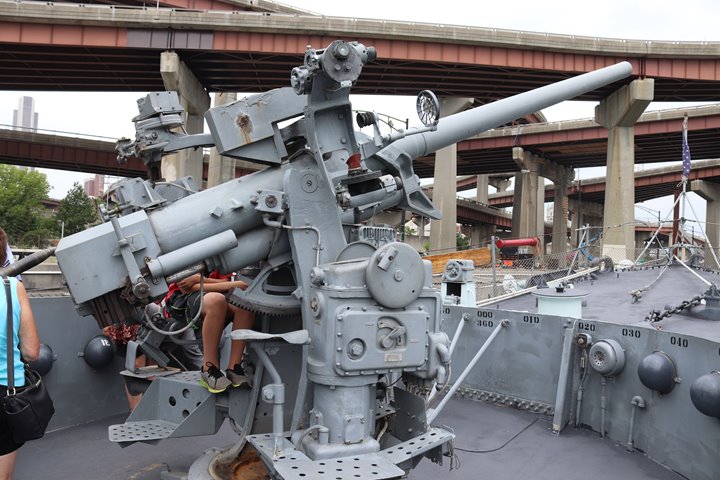
The tour guide encouraged those on the tour
to get on the gun mount and operate the elevation and transverse
controls. Author's photo.
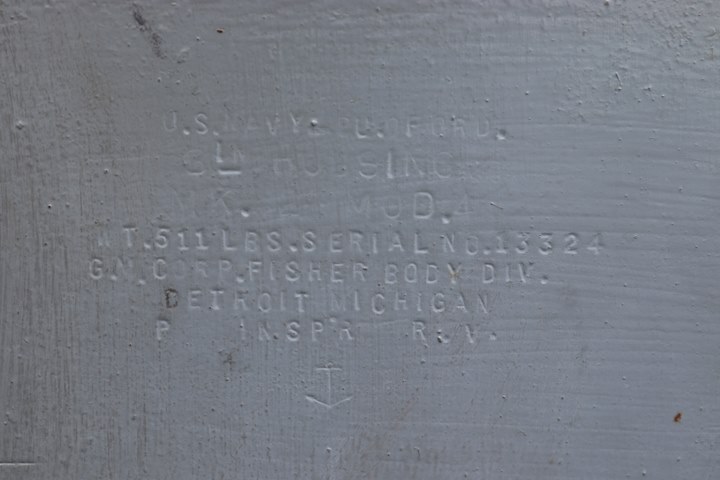
This is Fisher Body three-inch breech serial
number 13324. Author's photo.
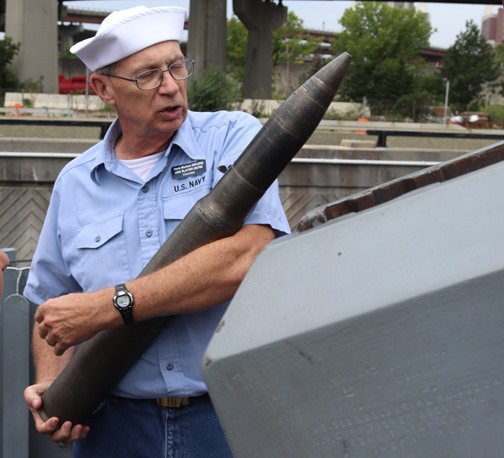
The tour guide showed the size of the
three-inch round to my tour group. Author's photo.
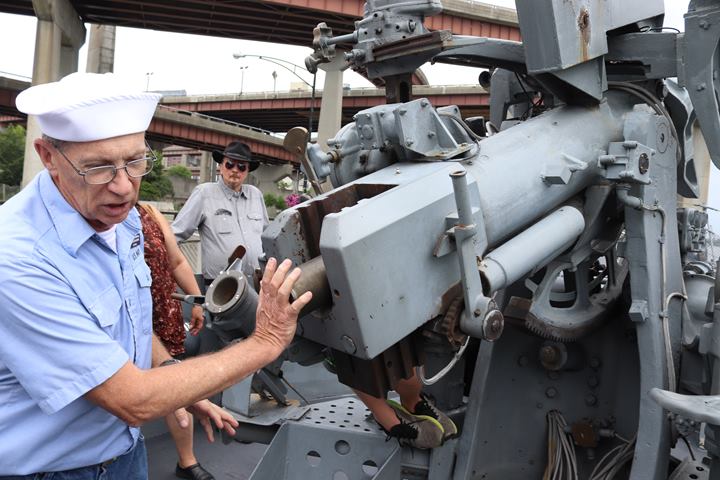
Here the tour guide is showing how the shell
is inserted into the Fisher Body-built breech. Author's photo.
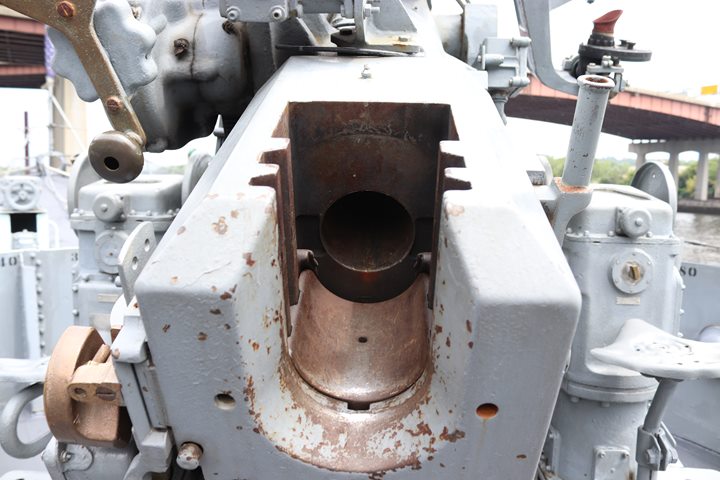
Author's photo added 8-25-2017.
90 mm Anti-Aircraft Gun:
Fisher Body Pontiac, MI Plant: This plant built 2,359 90mm
anti-aircraft guns with the parts furnished by several other General
Motors plants. Buick supplied all of the gun mounts for the
weapons, Chevrolet provided at least
2,000 each of the needed Breech Blocks, Breech Rings, and Recoil
Rails It also bored and rifled the 15-foot gun tube.
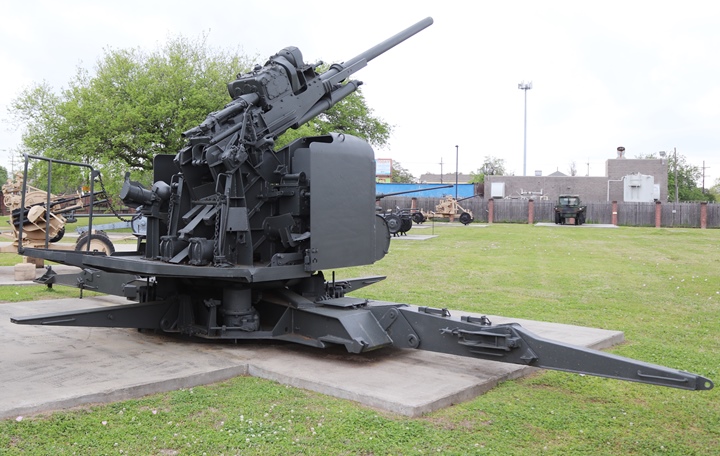
This 90mm anti-aircraft gun is on display at
Jackson Barracks in New Orleans. It is representative of the 2,359
built by the Pontiac Plant of the Fisher Body Division during World War
Two. Author's photo.
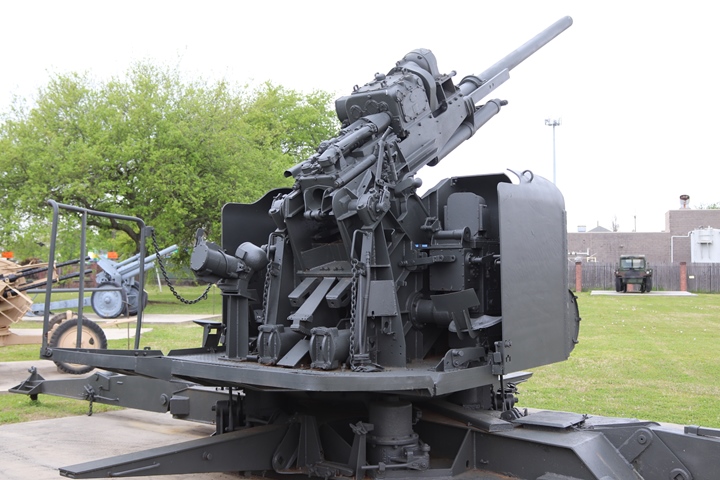
Author's photo.
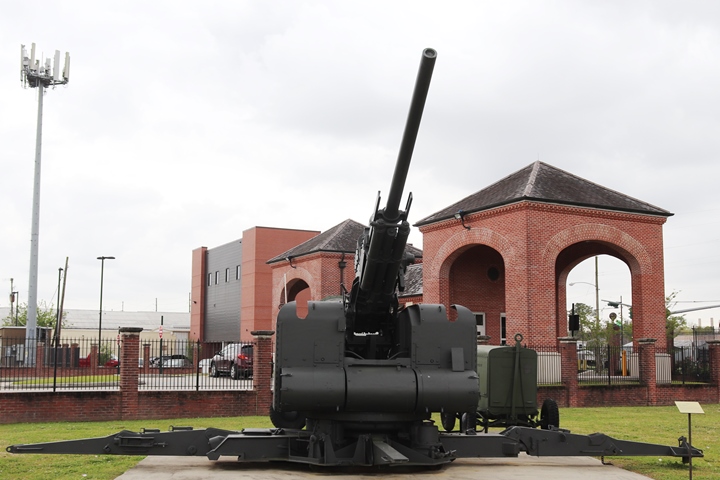
Author's photo.
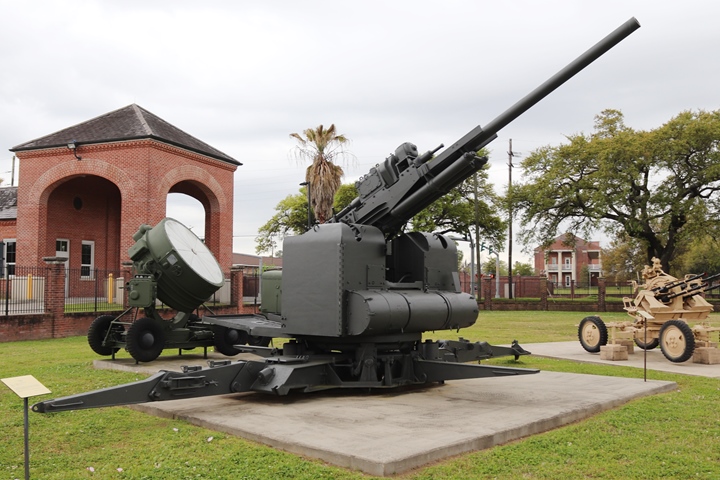
Author's photo.
120mm Anti-Aircraft Guns: The
Grand-Rapids plant of the Fisher Body Division of General Motors built
all 550 of the 120mm anti-aircraft guns produced. Buick provided
the gun mounts. There are only a few of the 120mm anti-aircraft
guns left. I have provided several photos below of the weapon on
display at the USS Alabama in Mobile, AL to show all the features and
complexity of the weapon.
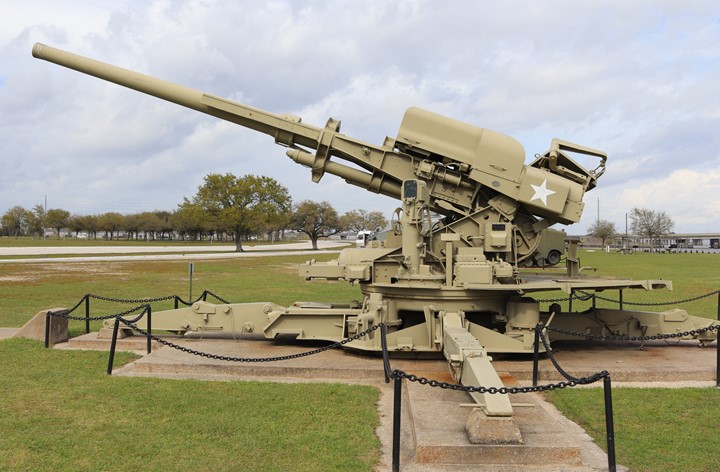
This is one of the few surviving 120mm M1
anti-aircraft guns of the 550 built by Fisher Body Grand Rapids during
World War Two. Author's photo.
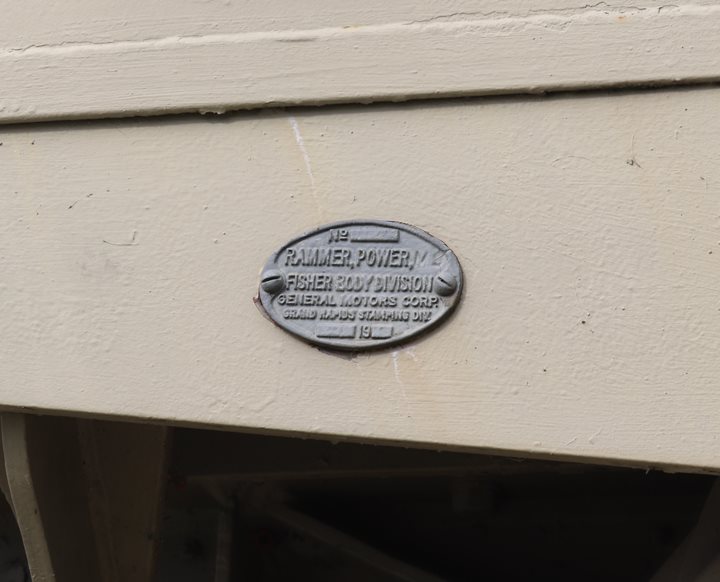
The M120mm anti-aircraft gun was the
signature weapon produced by Fisher Body Grand Rapids Stamping Plant
during
World War Two. The Power Rammer was designed and built by the
Grand Rapids plant. Author's photo.
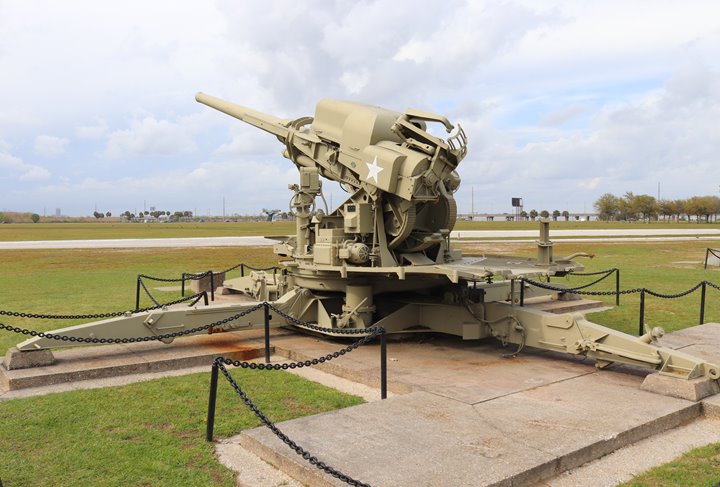
Author's photo.
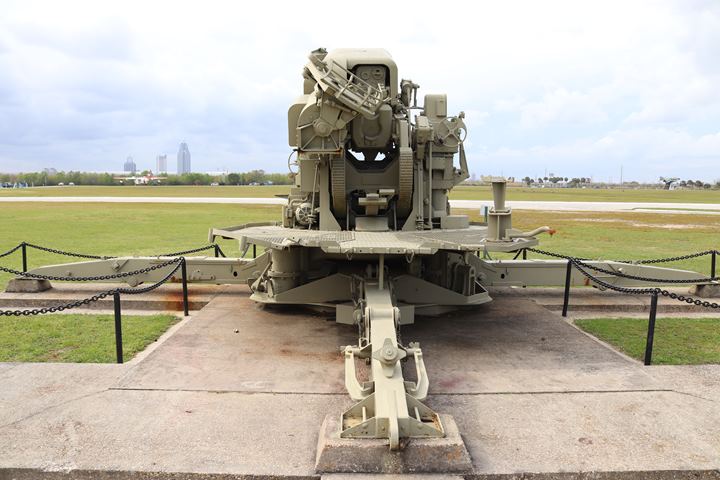
Author's photo.
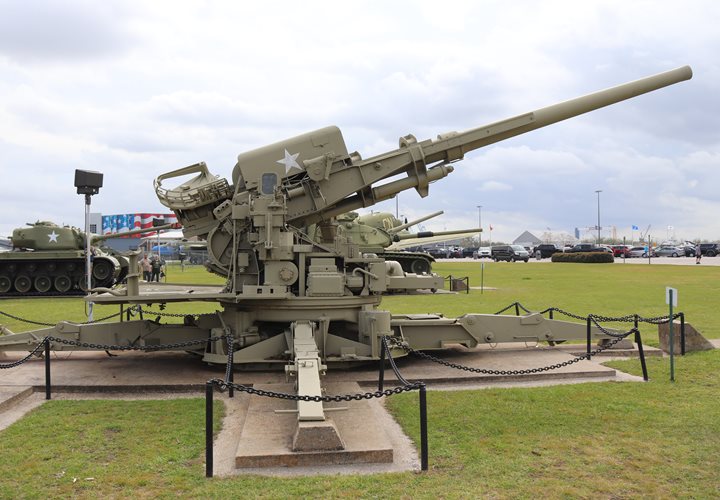
Author's photo.
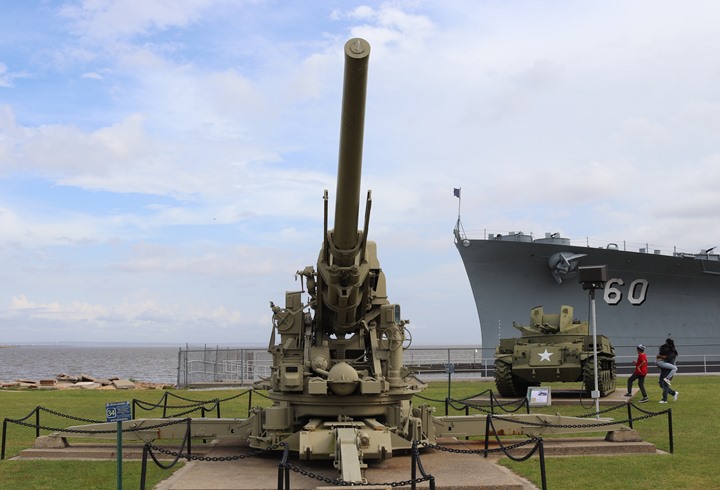
Author's photo.
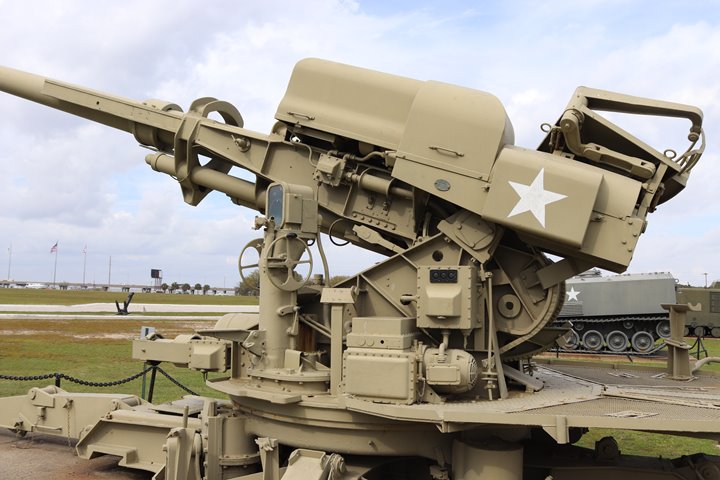
Author's photo added 3-20-2018.
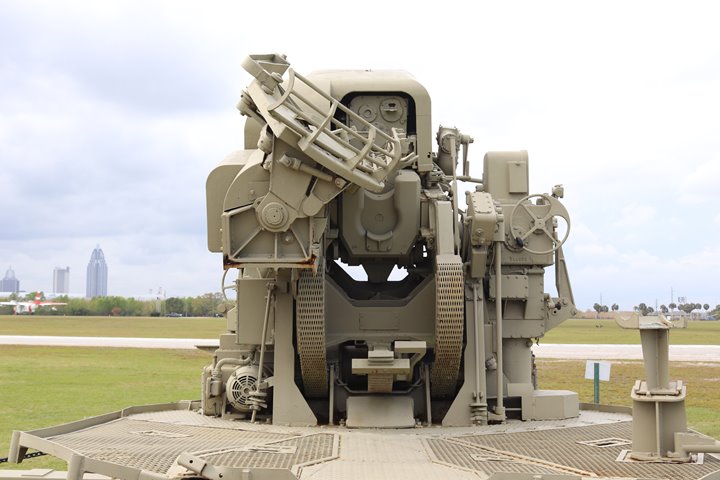
Author's photo added 3-20-2018.
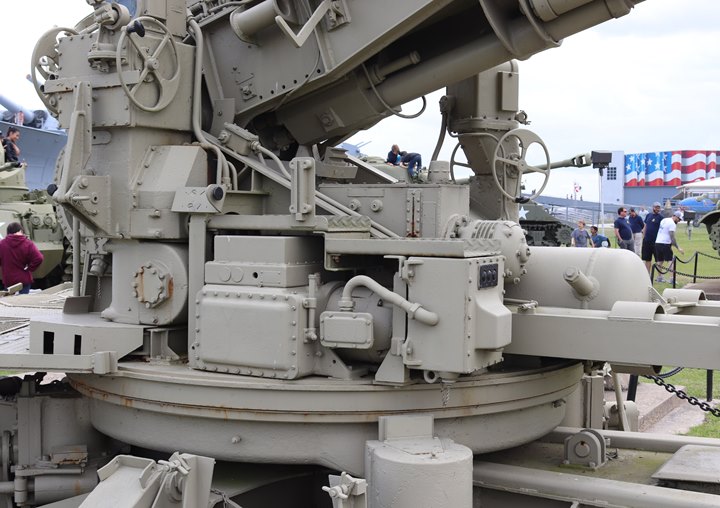
Author's photo added 3-20-2018.
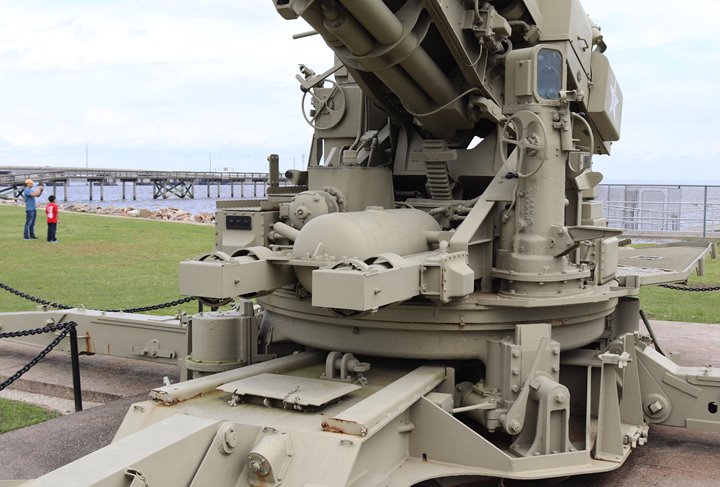
Author's photo added 3-20-2018.
One of the last known uses for the Fisher Body
Grand Rapids built M1 120mm anti-aircraft gun was at the Hanford
Engineering Works plutonium production reactor complex along the
Columbia River in Washington. In the early 1950s, 16 batteries of
four M1 anti-aircraft guns were set up around the facility as the Cold
War heated up. 5,000 soldiers of the 501st, 518th, and 519th AAA
Battalions manned the 64 M1s against an air attack from the Soviet
Union. In 1955 the M1s were phased out and replaced by Nike Ajax
anti-aircraft missiles.
5-inch/38-caliber Naval Dual-Purpose Guns:
Both the Fisher Body Grand Rapids, MI and Detroit Die and Machine plants
built 6,342 breech housings for these weapons. The Detroit Die and
Machine plant started producing the housing in April 1941. It
received the Navy "E" flag for shipping breech housings only five months after tooling
began. The Grand Rapids Fisher Body plant tooled up in 1943.
By
March 1944, the two plants were producing 300 5-inch housings per month.
The Pontiac, MI Fisher Body plant produced 480
gun mounts for the five-inch gun between September 1943 and January
1945.
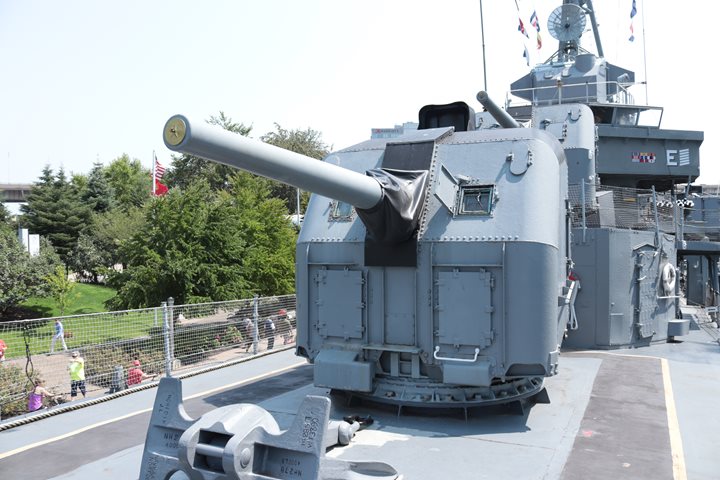
The
Fisher Body Die and Machine plant in Detroit and the Fisher Body in Grand Rapids produced naval gun breeches for five-inch, 38-caliber guns like this one. This five-inch gun can be
seen at the USS Sullivans at the Buffalo and Erie County Naval and
Military Park in Buffalo, NY. Author's photo.
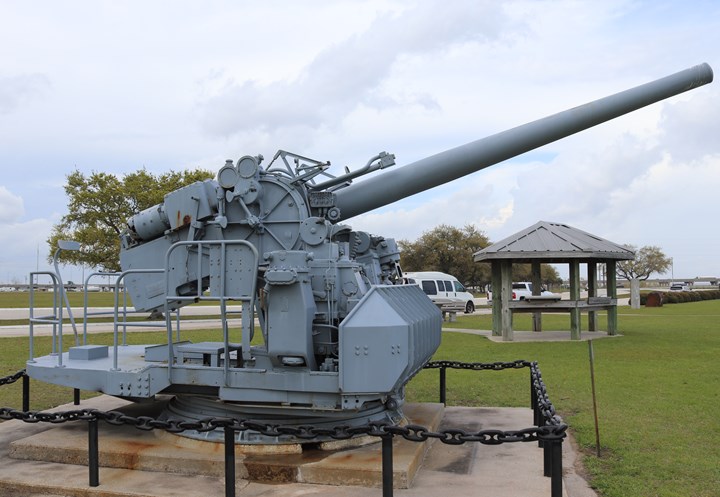
This is one of four five-inch, 38 caliber
naval guns without the turret armor. It is on display at the USS Alabama.
This allows for an excellent inspection of both the breeches and the
mounts. Many non-combat ships had five-inch guns like these for
defensive protection. Liberty ships had a five-inch gun like this,
manned by a Navy crew, on the fantail of these important transport
ships. Author's photo.
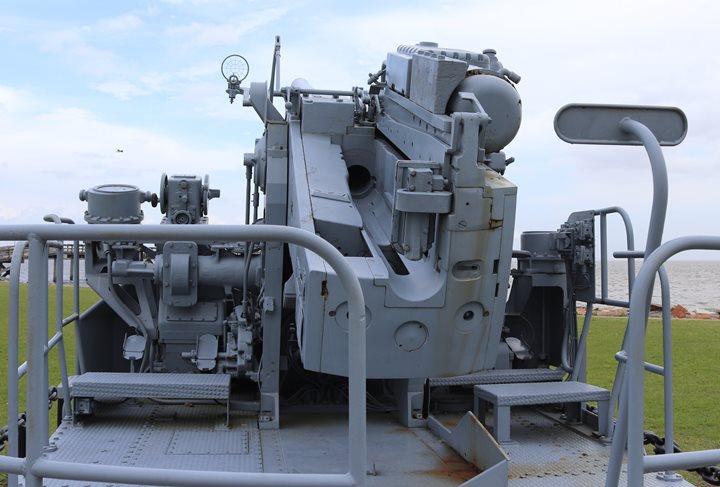
The gun mechanism was a complicated and
precision device consisting of 218 components. The Fisher Body
built breech housing weighed 2,932 pounds. It is the component in the
center of the gun mechanism with the opening for the five inch round, to
which the remaining 217 components were added. Author's photo.
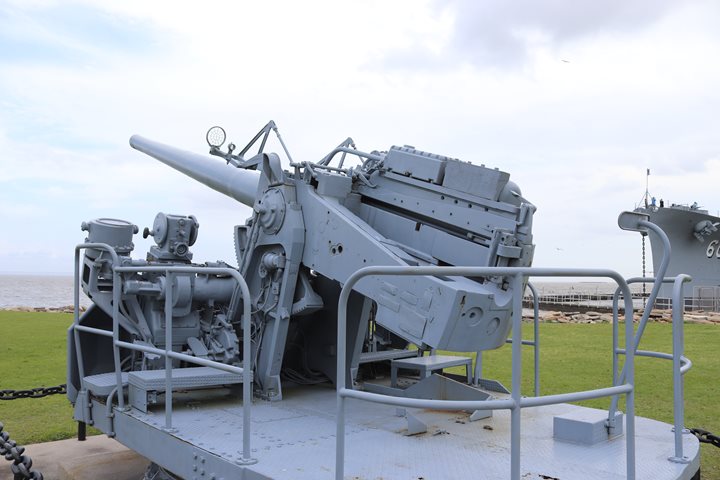
One of the seven different components that Fisher Body Pontiac
assembled into the gun mount weighed 5,250 pounds. This was a huge
undertaking on the part of Fisher Body Pontiac. Author's photo.
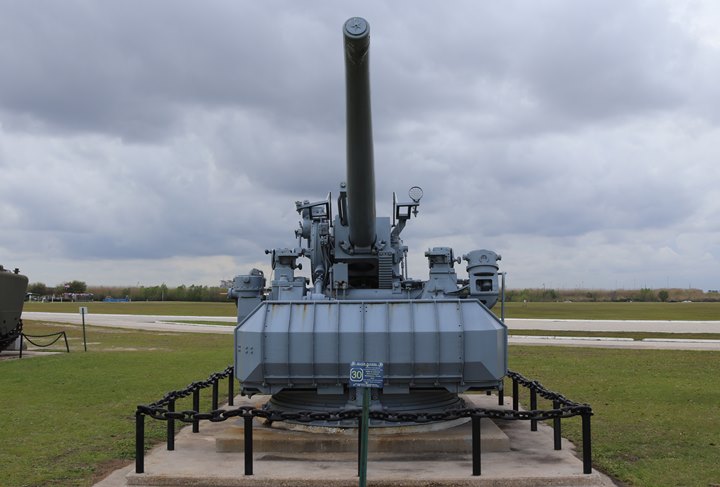
Author's photo.
|



































































